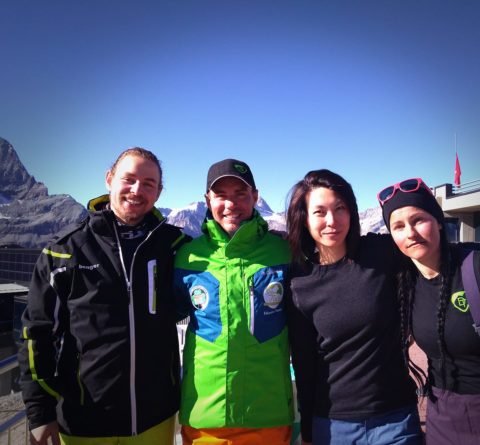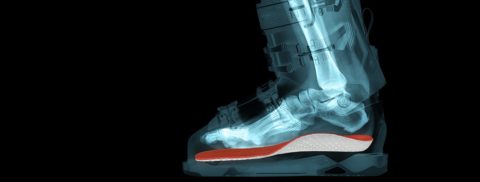A Guide to Buying Ski Boots
A Guide by Trainee Instructors
Ski boots can be tricky; finding the correct fit, style, flex suitable for your skiing can be difficult but with a few tips to prepare you what to look for in your perfect ski boot, one of the most important parts of your equipment will be a pleasure, not a chore, to wear!

Dan, Federico (Coach), Audrey and Vita
Hi ! We are the Subzero trainees on the Autumn Gap Course; Audrey, Vita and Dan. One of the topics we’ve been talking about over the first few weeks has been ski boots; we’d all been holding off getting a new pair hoping Diamonds could give us a bit of advice, and we weren’t disappointed.
In fact, we’ve learnt so much we were challenged to share it.
Why are good ski boots important?
Ski boots are one of the most important parts of our equipment and it’s essential to have a well-fitting pair that allows us to ski all day every day. With so many models of ski boot out there, it can be a bit overwhelming. It can be awfully tempting to pick a pair of ski boots based on the style and appearances, or simply one with a major discount on the internet and hope for the best.
Boot fitting can feel overwhelming and complicated. It starts with a measurement of your feet’s length and width at the longest points across. Everyone’s foot, like snowflakes, are unique. You learn that one is longer than the other and one is wider than the other. That’s normal! However, depending on the extent of these differences a compromise will have to be made. The aim in boot fitting is to find a size and shape that matches our feet.
Some fitters may get very over-technical at this point, but this really is a simple process – find the boot that best fits the foot.
Before we start, check out the Subzero guide to the different types of ski boot available on the market here.
When choosing your new ski boots, take the following factors into consideration:
 1. Fit
1. Fit
Mondopoint is the scale system widely used when measuring foot size. Our foot is measured from heel to the longest toe in centimetres; this is the length size.
Ideally in the shop the boot will feel quite tight as the liner inside the boot will gradually compress so snug fit when first fitting is recommended.
2. Width (Last)
Another important criteria when measuring foot, it is measured by the widest point of the foot. Generally most brands have more than 2 width sizes to fit various types of feet, from narrow width (97mm to 98mm), average width (around 100mm), and to wide last (102mm to 106mm).
TRICKY BIT: the width indicated by 98mm/100mm/102mm under the sole, does not mean actual width as a longer boot will have a proportionally greater width (usually 2mm+/- per 1+/- size). Thus, if a boot is too short but fits the width, going up a size may not solve the problem, because going up a size will compromise the tightness of the width (which could be wider). Going up a size in a narrower model will likely yield the desired fit.
3. Flex
In theory the higher the flex number the stiffer the boot is, allowing improved power transfer from the core to the skis. However these numbers are not uniform across brands as there is no industry standard. Ergo a 110 flex from one brand might feel softer than others with the same listing. Height, weight, ability, and skiing style are also contributing factors when choosing the best flex.
4. Forward Lean
Alpine ski boots are normally fixed with forward lean from 12 degrees to 18 degrees, and the forward lean and ramp angles are generally adjustable. Finding the perfect angle, the sweet spot, can be quite personal, everyone has their own preferences. Your anatomy, bio mechanics and posture come into play at this point.

Image: Powder Hound Ski Shop
There is a lot of discussion around ski boots and your boot fitter should try to explain in several different ways how it should feel to you. However if you’d never had a properly fitting boot the advice and descriptions can be hard to comprehend. Take your time, try on multiple pairs and compare. You’ll never know until you try on the boots yourself.
ADVICE: Some would tell you that you should have two designated pairs, one for teaching and one for performance, others will tell you to have a single pair. Subzero Coaching advises to have just one; a trainee instructor can still be working on their own technique whilst teaching. If not, you can be missing out on improving the foundations of your own skiing.
Other things we have learnt;
- Don’t be that person who chooses a 130 flex for no other reason than you ‘think’ that’s what good skiers use
- Cranking up boots to maximum tightness isn’t necessary – all that’s doing is blocking your ankle joint from moving
- For warmth thin technical socks are much better than thick socks
- Consider investing in custom foot beds made so your foot is correctly supported inside the boot, or at least buying good insoles such as SureFeet
- The boots will not necessarily have identical buckling sequence on each side
- Experienced skiers can experiment with skiing with looser/completely open boots to have a better feel for feet movement and body positioning in relation to the boot (warning: at your own risk!! If experimenting with this low speed and an easy gradient should be used i!!)
- It is just plain silly to spend 6 hours torturing one’s feet every day!
A huge thanks to Daniel O’Dor, Audrey Chuang and Vita Kence (Subzero Autumn Gap trainees) for writing this article. Guidance from Lee (Julen Sport Zermatt) and Federico Sollini.
Edited by Caroline George